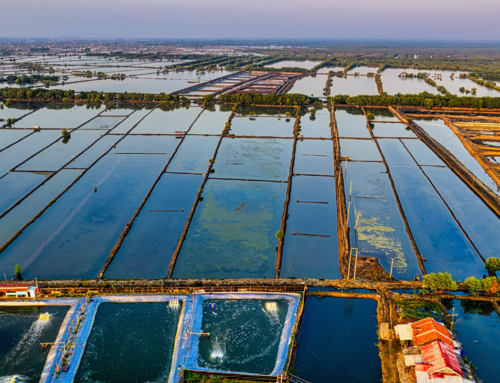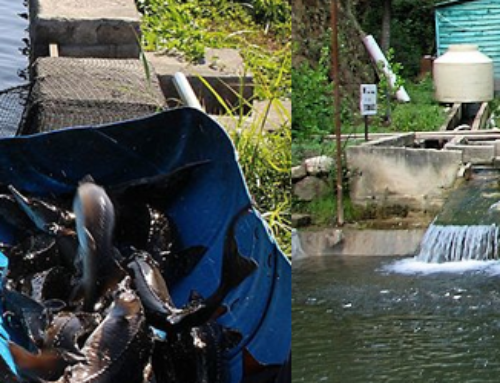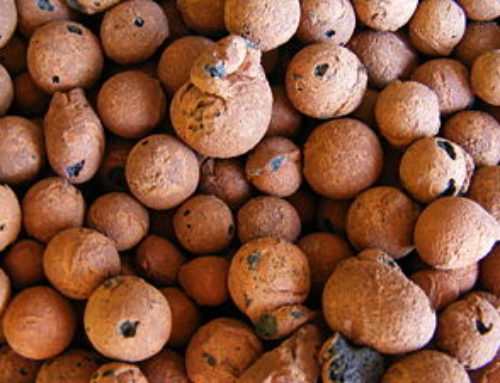MEDIA BED TECHNIQUE
Media-filled bed units are the most popular design for small-scale aquaponics. This method is strongly recommended for most developing regions.
These designs are efficient with space, have a relatively low initial cost and are suitable for beginners because of their simplicity.
 In media bed units, the medium is used to support the roots of the plants and also the same medium functions as a filter, both mechanical and biological.
In media bed units, the medium is used to support the roots of the plants and also the same medium functions as a filter, both mechanical and biological.
Water evaporation is higher in media beds with more surface area exposed to the sun. There are many designs for media beds, and this is probably the most adaptable technique.
Media bed construction
 Intermediate Bulk Containers
Intermediate Bulk Containers
Media beds can be made from plastic, fibreglass or a wooden frame with water-tight rubber or polyethylene sheeting on the base and inside the walls. The most popular “do-it-yourself” (DIY) media beds are made from plastic containers, modified IBCs or even old bathtubs.
It is possible to use all kinds of tanks so long as they meet these following requirements:
- strong enough to hold water and growing media without breaking;
able to withstand difficult weather conditions - made of food grade material that is safe for the fish, plants and bacteria
- can be easily connected to other unit components through simple plumbing parts
- can be placed in close proximity to the other unit components.
Shape
The standard shape for media beds is a rectangle, with a width of about 1 m and a length of 1–3 m. Larger beds can be used / manufactured, but they require additional support (i.e. concrete blocks) in order to hold their weight. In addition, longer beds may have unequal distributions of solids that tend to accumulate at the water inlet, raising the risk of anaerobic spots. The beds should not be so wide that the farmer/ operator is unable to reach across, at least half-way.
Depth
Media bed depth is important because it controls the amount of root space volume in the unit which determines the types of vegetables that can be grown. If growing large fruiting vegetables such as tomatoes, okra or cabbage, the media bed should have a depth of 30 cm, without which the larger vegetables would not have sufficient root space, would experience root matting and nutrient deficiencies, and would probably topple over. Small leafy green vegetables only require 15–20 cm of media depth, making them a good choice if the media bed size is limited.
Choice of medium
All applicable growing media will have several common and essential criteria. The medium needs to have adequate surface area while remaining permeable for water and air, thus allowing the bacteria to grow, the water to flow and the plants roots to breathe.
The medium must be inert, not dusty, and non-toxic, and it must have a neutral pH so as not to affect the water quality.
It is important to wash the medium thoroughly before placing it into the beds, particularly volcanic gravel which contains dust and tiny particles. These particles can clog the system and potentially harm the fishes’ gills.
The essential criteria are listed below:
- large surface area for bacterial growth
- neutral pH and inert (meaning the medium will not leach out any potentially toxic substances)
- good drainage properties
- easy to work with
- sufficient space for air and water to flow within the medium
- available and cost effective
- light weight, if possible.
Several common media meeting the criteria are discussed include:
Volcanic gravel
The most popular medium to use for media bed units and is recommended where available.
The three best qualities of volcanic gravel are that it has a very high surface area to volume ratio, it can be cheap and easy to obtain, and it is almost chemically inert.
Volcanic gravel has a surface area to volume ratio of about 300 m2 /m3 depending on the particle size, which provides ample space for bacteria to colonise.
Once washed of dust and dirt, volcanic gravel is almost completely chemically inert, except for small releases of microelements such as iron and magnesium and the absorption of phosphate and potassium ions within the first few months of starting a unit. The recommended size of volcanic gravel is 8–20 mm in diameter.
Light expanded clay aggregate (LECA)
Light expanded clay aggregate (LECA) consists of expanded clay pebbles. These pebbles are round in shape and very lightweight compared with other substrates. They are very comfortable to work with and ideal for rooftop production. The surface area of LECA is about 250–300 m2 /m3 , which is within the target range. However, LECA is relatively expensive and not widely available around the world. It comes in a variety of sizes; for aquaponics the larger sizes with diameters 8–20 mm are recommended.
Other possible media choices
If the above-listed media are unavailable, it is possible to use other media. Alternatives include: river-bed gravel, which is usually limestone but can have a low surface area to volume ratio depending on the granulometry; pumice (also rockwool); recycled plastic, although plastic floats and needs to be held submerged with a layer of gravel on top; or organic substrates such as coconut fibre, sawdust, peat moss or rice hull, which are often inexpensive but risk becoming anoxic, deteriorating over time and clogging the system.

Displacement of water by media
Depending on the medium, it will occupy roughly 30–60 percent of the total media bed volume. This percentage will help decide on the sump tank size for each unit, because the sump tank, at the very least, will need to hold the total water volume contained in all the media beds.
Sump tanks should be slightly oversized to ensure that there is always adequate water for the pump to run without ever running dry.
For example, for a media bed of 1000 litres (dimensions 2 m long × 2 m wide × 0.25 m medium depth), the growing medium will displace 300–600 litres of this space, and therefore the water volume of the media bed would be 400–700 litres.
It is recommended that the sump volume be at least 70 percent of the total media bed volume.
Media Bed Filtration Capacity
The media beds serve as very efficient filters, both mechanical and biological. Unlike the NFT and DWC systems, the media bed technique utilises a combination filter and plant growing area. In addition, the media bed provides a place for mineralization to occur, which is absent in the NFT and DWC systems. However, at high stocking densities (>15 kg/m3 ), the mechanical filtration can be overwhelmed and can face the risk of having the media clogged and producing dangerous anaerobic spots, where mechanical filters has to be added to the system.
Solids capture device can be integrated into the unit design, where the stocking density exceeds 15 kg/m3 and/or if the feeding rate is above 50 g/day for each square metre of grow bed.
The three zones of media beds – characteristics and processes
The nature of a flood-and-drain media bed creates three separate zones that can be considered microecosystems, which are differentiated by their water and oxygen content. Each zone hosts a diverse group of bacteria, fungi, micro-organisms, worms, insects and crustaceans. One of the most important is the nitrifying bacteria used for biofiltration, but there are many other species that all have a role in the breaking down of fish wastes. It is not essential to be aware of all these organisms, but this section briefly outlines the differences between these three zones and some of the ecological processes occurring in each.
Dry Zone
The three zones of a media bed during the drain cycle
The top 2–5 cm of the bed is the dry zone
The dry zone functions as a light barrier, preventing light from hitting the water directly which can lead to algal growth. It also prevents the growth of fungus and harmful bacteria at the base of the plant stem, which can cause collar rot and other plant diseases. Another reason to have a dry zone is to minimize evaporation from beds by covering the wet zone from direct light. Moreover, beneficial bacteria are sensitive to direct sunlight.
Dry/Wet Zone
The three zones of a media bed during the flood cycle
This is the zone that has both moisture and high gas exchange. In flood-and-drain techniques this is the 10–20 cm space where the media bed intermittently floods and drain. If not using flood-and-drain techniques, this zone will be the path that the water flows through the medium. Most of the biological activity will occur in this zone. The root development, the beneficial bacteria colonies and beneficial micro-organisms are active in this zone. The plants and the animals receive their water, nutrients and oxygen because of the interface between air and water.
One common technique is adding worms to the media bed which will live in this dry/wet zone.
The worms will contribute to the breakdown of solid fish waste and they will also consume any dead leaves or roots. This activity will prevent wastes from clogging the system. This Site explains in detail about its importance and how useful this process is.
The Wet Zone
This zone, the bottom 3–5 cm of the bed, remains permanently wet. In this zone, the small particulate solid wastes accumulate, and, therefore the organisms that are most active in mineralization are located here. These include heterotrophic bacteria and other micro-organisms. These organisms are responsible for breaking down the waste into smaller fractions and molecules that can be absorbed by the plants through the process of mineralization.
Irrigating Media Beds
There are different techniques to deliver water to media beds, each can be relevant depending on the local availability of materials, the degree of technology desired or the experience of the operators.
Continuous Flow
Water can be simply trickled from holed pipes uniformly distributed on the medium; this is a perfectly acceptable design.
These water distribution systems can become clogged with solid fish waste and should be periodically cleared.
Flood & Drain
A method called flood-and-drain, also known as ebb-and-flow, can be used where the system of plumbing causes the media beds to flood with water from the fish tank and then drain back in the sump tank. This is accomplished through autosiphons or timed pumping.
This alternation between flooding and draining ensures that the plants have both fresh nutrients and adequate air flow in the root zone.
Usually, these systems go through the complete cycle 1–2 times every hour, but some successful systems only cycle 3–4 times per day. Flood-and-drain designs are not the only techniques for media beds, and managing the water flow cycle may be frustrating and time-consuming for novice operators.
Bell Siphon
The bell siphon is a type of autosiphon that exploits a few physical laws of hydrodynamics and allows the media bed to flood and drain automatically, periodically, without a timer. The action, timing and ultimate success of the siphon are dependent on the water’s flow rate into the bed, which is constant. Bell siphons can nevertheless be finicky and require attention.
Water flow dynamics
Water flows into each grow bed at a constant flow rate. As the water fills the grow bed it reaches the top of the standpipe, and begins to drip through the standpipe back to the sump tank. Without the bell portion of the bell siphon, this would create a condition of constant water height. Instead, as the water continues to fall through the standpipe, the bell, which sits over the standpipe something like a hat, acts as an air tight lock and produces a siphon effect. This suction within the bell starts the siphon. Once started, all the water from the bed starts to rapidly flush down the standpipe as the bell keeps its air tight seal.
The draining through the standpipe is faster than the constant inflow from the fish tank. When the water in the grow bed drains all the way down to bottom, air enters the bottom of the bell and immediately stops the siphon.
The water then slowly fills back up and repeats the whole cycle again continuously.
Main components of a bell siphon
The three main components of a bell siphon are described below. The dimensions of the standpipe, bell and media guard are completely dependent on the size of the grow bed and incoming water flow rate. These dimensions are provided for a media bed of 1–3 m2 with a media depth of 30 cm, with an incoming water flow rate of 200–500 litres/h for each bed. For large grow beds, all of the components would be larger.
Standpipe
– The standpipe is constructed of a PVC pipe, 2.5 cm diameter, of a height of 22 cm. The standpipe passes through the bottom of the grow bed, connecting to the sump, and is the path of the water as it drains.
Bell
– The bell is a PVC pipe, 7.5 cm diameter, of a height of 25 cm. The pipe is capped with a PVC end-cap on top, and is open on the bottom where it fits over the standpipe. Two rectangular gaps, 1 cm × 4 cm, are located near the bottom of the bell, 1.5 cm up on opposite sides, through which the water is pulled up into the standpipe inside the bell. A final 1 cm hole is drilled 5 cm from the bottom to help break the siphon once the grow bed is drained by allowing air to enter.
Media Guard
– The media guard is a PVC pipe, 11 cm diameter, of a height of 32 cm with many small holes drilled in its sides. The media guard prevents the gravel from the grow bed from entering and clogging the standpipe, without obstructing the flow of water.
More to read click here.







